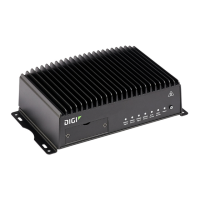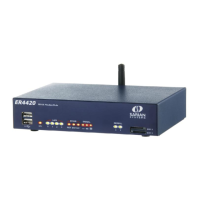Configuring legacy protocols Configure X.25 parameters
Digi TransPort® Routers User Guide
651
When the G facility code is specified in a CALL packet, it must be followed by the CUG number. This can
be a 2- or 4-digit number. If you are a member of a closed user group, the network may restrict you to
only making calls to or receiving calls from other members of the same group.
Reverse charging
Reverse charging, specified using the R facility code, allows outgoing calls to be charged to the
account of destination address. Whether or not a call is accepted on a reverse charging basis is
determined by the service provider and by the type of account held by the called user.
Calling user data
The calling user data field for a normal call can contain up to 12 bytes of user data. If the first
character is an exclamation mark (!), the PAD omits the 4-byte protocol identifier, and allows the full
16 bytes as user data. The same is true for a fast select call, except the maximum amount of user
data is increased from 124 to 128 bytes. When entering user data, you can use the tilde character (~)
to toggle between ASCII and binary mode. In ASCII mode, data is accepted as typed, but in binary
mode, you must enter each byte as the required decimal ASCII code separated by commas. For
example, to enter the data Line1 followed by [CR][LF] and Line2, enter:
DLi ne1~13, 10~Li ne2
CLR command: Abort a CALL command
To abort an X.25 CALL, use the X.28 CLR command, do one of the following:
n Press [Enter].
n Drop DTR from the terminal while the call is in progress. Dropping DTR will also terminate an
established call.
If a call is terminated by the network or by the remote host, the router returns a diagnostic message
before the NO CARRIER result code. Messages can be numeric or verbose, depending on the setting of
the ATV command.
Verbose messages and their numeric codes
The following table lists the verbose messages and equivalent numeric codes:
Note The router may abbreviate some verbose messages.
Code Verbose message
1 Unallocated (unassigned) number
2 No route to specified transit network
3 No route to destination
4 Channel unacceptable
6 Channel unacceptable
7 Call awarded and being delivered in an established channel
16 Normal call clearing

